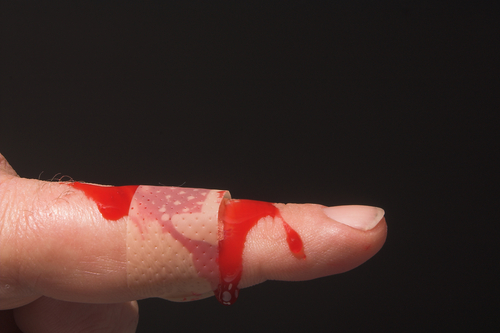
An injury has occurred and emergency personnel have been notified; however, in the interim, someone needs to perform first aid on the injured person. Although the paramedics, ER and doctors will surely know how to help, it sometimes comes too late. In some cases, initial first aid measures taken on the scene can make a huge difference – especially if the patient is being sent to a crowded ER with average wait times of at least 45 minutes. Following are some key points that may be of assistance in the crucial first few minutes.
1. Cut (cut off) fingers/body parts:
Amputation can occur in various situations, from chopping food to using an electric saw. Should an amputation occur, DO NOT try to preserve the loose part by placing it directly on ice. Instead, wrap the severed part in damp gauze (ideally, soaked in saline), place it in a watertight bag and place the bag on ice. Don’t forget to bring the bag and ice to the emergency room in case the doctors can re-attach the severed part. To treat the wound on the hand or body, apply ice to reduce swelling and cover it with a clean, dry cloth.
2. Knocked-out tooth:
DO NOT scrub the tooth hard – even if it’s dirty; a gentle rinse will suffice. Instead, put the tooth in milk and go straight to the ER (or emergency dental clinic) as the tooth could potentially be re-implanted.
3. Burns:
DO NOT apply ice, butter, or any other type of grease to a burn. DO NOT cover a burn with a towel blanket – or else loose fibers might stick to the skin. If the patient has a serious burn, DO NOT break any blisters or pull off clothing that has stuck to the skin. In the case of mild burns, wash the wound and apply antibiotic ointment. If the patient has burns to the eyes or genitals, take them to the hospital, regardless of the severity of the burn. As well, go to the hospital if the burn covers an area larger than the patient’s hand, or if the burn blisters or is followed by a fever.
4. Electrical burns:
In the case of any electrical burns, or contact with a jolt of electricity (lightning, power lines, electrical cords, etc.), the patient should always seek immediate medical attention – even if no damage is apparent. Many people die each year from electrical burns, which can lead to invisible, very serious injuries that go much deeper than just the skin.
5. Sprained ankle:
Although it may provide comfort in the face of pain, DO NOT use a heating pad on a sprained ankle. Instead, treat the sprain with ice, and go to the ER if it is very painful to put weight on the injury – this may be an indication of a fracture.
6. Nosebleed:
DO NOT allow the patient to lean back, and DO NOT allow them to blow their nose or bend over when the bleeding subsides. Instead, the patient should sit upright and lean forward, pinching their nose just below the nasal bone for five to 10 minutes. Go to the ER if the bleeding continues for more than 15 minutes, or if the patient thinks that they are swallowing a lot of blood.
7. Bleeding:
DO NOT use a tourniquet, as that can cause permanent tissue damage. Instead, apply steady pressure to the wound, using a clean towel or gauze pack. Wrap the wound securely, and take the patient to the ER if the wound was cause by an animal bite, if the wound is gaping, or if the bleeding doesn’t stop. As well, keep the victim warm to help prevent them from going into shock.
8. Poison Ingestion:
DO NOT induce vomiting, or use Ipecac syrup (unless instructed by emergency personnel). Instead, call poison control, and remember to bring the ingested substance (in its container) to the ER.
9. Impalement:
DO NOT remove the object from its point of entry, which could cause further damage or increase the risk of bleeding. Instead, stabilize the object and go to the ER.
10. Seizures:
DO NOT put anything in the victim’s mouth. Instead, lay the victim on the ground (preferably in an open space) and roll the victim onto their side.
These are just a few guidelines for the safe administration of immediate on-site first aid care. If you are unsure of how to best attend to a patient’s needs, call 911 and confer with the emergency operator; if the injury seems to require medical attention, ask the operator to send an ambulance, or rush the patient to the ER. Remember, the first few minutes following an accident can be the most critical, and can save the victim from unnecessary suffering and potential complications. When responding to any emergency situation (in particular an injury), try to act in a calm, methodical and clear-headed manner – it will not only help to put the patient at ease, but may also help ensure that no mistakes or oversights are made in the wake of the injury.
Simply Safety! incident management software can help protect you and your company by allowing you to be proactive in reducing risk and associated costs and keeping an accurate due diligence trail. Simply Safety! software program replaces paper-based or spreadsheet tracking with a modern efficient way to manage critical compliance data.
Looking for a better way? Call 1 800 862-9939 today to book a 20 minute online web demo of Simply Safety! for your management team!
Visit the Simply Safety! products page.
